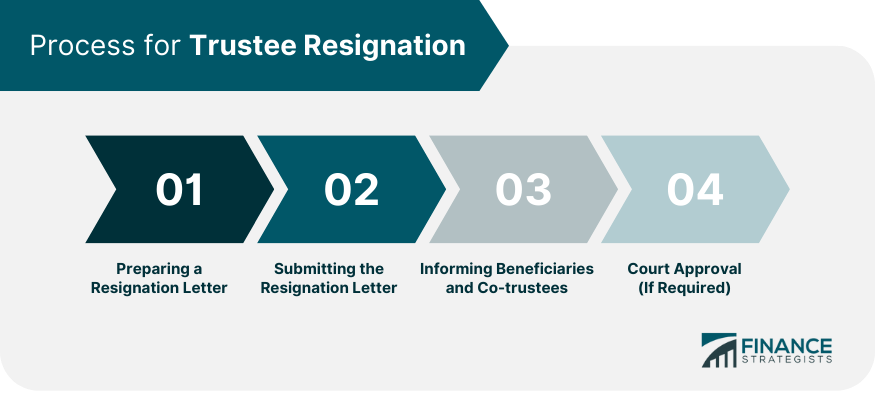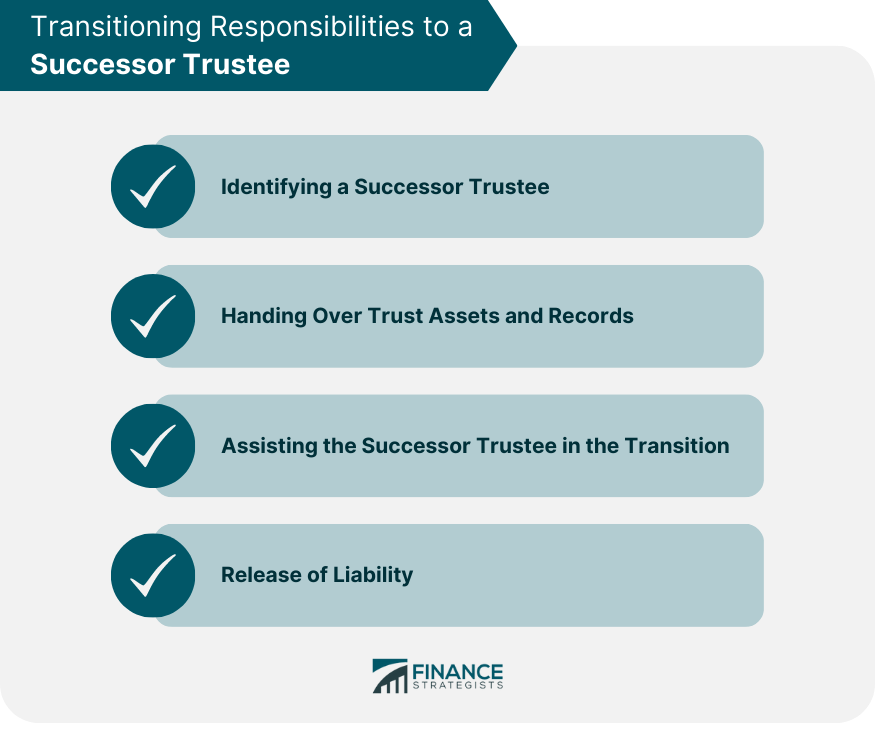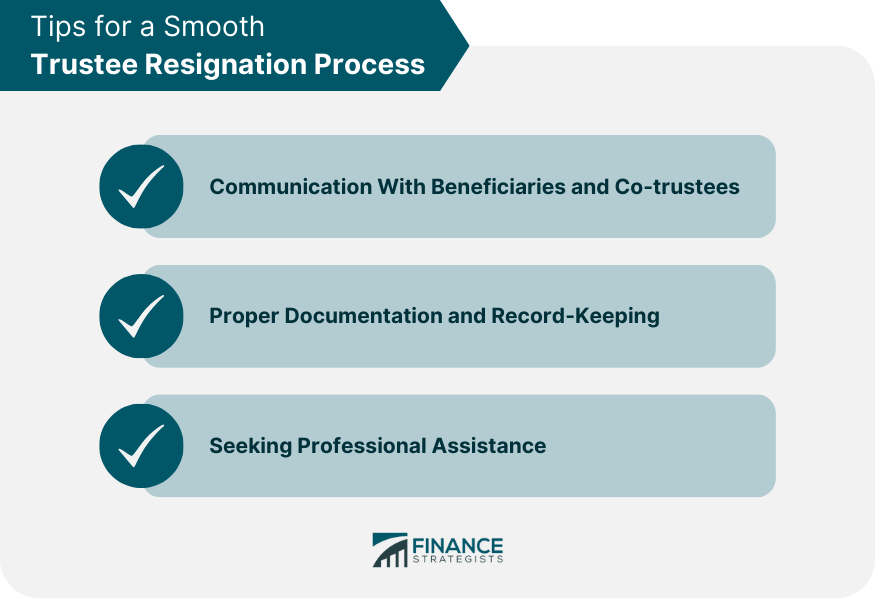A trustee is an individual or institution responsible for managing a trust's assets on behalf of the trust's beneficiaries. Trustees have a fiduciary duty to act in the best interests of the beneficiaries and to administer the trust according to the trust agreement and applicable laws. Trustees have various responsibilities, including managing trust assets, distributing income and principal to beneficiaries, maintaining records, and filing tax returns. They must also act impartially, prudently, and in good faith when fulfilling their duties. A trustee may resign for personal reasons, such as health issues, changes in personal circumstances, or conflicts of interest. Additionally, beneficiaries or co-trustees may request a trustee's resignation if they believe the trustee is not fulfilling their duties. The trust agreement typically outlines the process and requirements for a trustee's resignation, including any required notice period and the steps for appointing a successor trustee. State laws may also govern the resignation process and provide additional requirements or procedures that must be followed. A trustee may voluntarily resign if they believe they can no longer fulfill their duties effectively or if personal circumstances prevent them from continuing in their role. Involuntary resignation may occur if a trustee is removed by a court, co-trustees, or beneficiaries due to misconduct, incapacity, or other valid reasons. Trustees must generally provide written notice of their resignation to the trust's beneficiaries and co-trustees. The trust agreement or state law may specify additional notice requirements or timeframes. A trustee should prepare a formal, written resignation letter that includes the effective date of resignation, the reason for resigning, and any relevant information about the trust's administration. The trustee should submit their resignation letter to the appropriate parties, such as the trust's beneficiaries, co-trustees, or the trust's attorney. The resigning trustee must inform the beneficiaries and co-trustees of their resignation and provide any necessary information to ensure a smooth transition. In some cases, court approval may be required for a trustee's resignation, especially if the trust is subject to ongoing litigation or if the resignation is involuntary. If a co-trustee is already serving alongside the resigning trustee, they may assume the resigning trustee's responsibilities. If there is no co-trustee, the trust agreement or state law may outline the process for appointing a new trustee. This may involve the beneficiaries, a trust protector, or a court selecting a successor trustee. The resigning trustee must transfer all trust assets, records, and relevant documentation to the successor trustee to ensure a seamless transition. The resigning trustee may provide assistance to the successor trustee during the transition, such as explaining the trust's administration, providing guidance on trust assets, and offering support in understanding the trust agreement. The resigning trustee should obtain a release of liability from the beneficiaries and co-trustees to protect themselves from future claims related to their tenure as trustee. This release may be in the form of a written agreement or a court order. A trustee's resignation can temporarily disrupt the administration of the trust. However, with proper planning and communication, the transition to a successor trustee can minimize any negative effects. If a trustee resigns without following the proper procedures outlined in the trust agreement or state law, they may face legal consequences, such as liability for breach of fiduciary duty or other claims from beneficiaries. The resignation of a trustee can impact trust assets and beneficiaries, particularly if the trustee's resignation is sudden or unexpected. A smooth transition to a successor trustee can help mitigate any adverse effects on the trust's assets or beneficiaries. Open communication with beneficiaries and co-trustees is essential during the resignation process. This can help minimize misunderstandings, maintain trust, and ensure a seamless transition. Maintaining accurate and up-to-date records of trust administration is crucial during a trustee resignation. Proper documentation can help avoid disputes and ensure a smooth handover to the successor trustee. Trustees should consider consulting with an attorney or financial advisor experienced in trust administration during the resignation process. This can help ensure that all legal requirements are met and minimize any potential liabilities. Trustee resignation involves various legal aspects and procedural requirements, which may be governed by the trust agreement and state laws. Proper communication, documentation, and assistance from professionals can help ensure a smooth trustee resignation process and minimize any negative impacts on trust administration, assets, and beneficiaries. Adhering to proper trustee resignation procedures is essential to protect the resigning trustee from potential liabilities, ensure the continued administration of the trust, and maintain the trust's purpose and beneficiaries' interests. By following the appropriate procedures and ensuring a smooth transition to a successor trustee, the resigning trustee can help safeguard the trust's assets and promote the continued administration of the trust for the benefit of its beneficiaries.Trustee Resignation: Overview
Definition of a Trustee
Roles and Responsibilities of a Trustee
Reasons for Trustee Resignation
Legal Aspects of Trustee Resignation
Governing Documents
Trust Agreement
State Laws
Grounds for Resignation
Voluntary Resignation
Involuntary Resignation
Notice Requirements
Process for Trustee Resignation
Preparing a Resignation Letter
Submitting the Resignation Letter
Informing Beneficiaries and Co-trustees
Court Approval (If Required)

Transitioning Responsibilities to a Successor Trustee
Identifying a Successor Trustee
Co-trustee
Appointing a New Trustee
Handing Over Trust Assets and Records
Assisting the Successor Trustee in the Transition
Release of Liability

Implications of Trustee Resignation
Impact on Trust Administration
Potential Legal Consequences
Effect on Trust Assets and Beneficiaries
Tips for a Smooth Trustee Resignation Process
Communication With Beneficiaries and Co-trustees
Proper Documentation and Record-Keeping
Seeking Professional Assistance

Conclusion
Trustee Resignation FAQs
A Trustee Resignation is when a trustee steps down from their position and is no longer responsible for managing a trust. The resignation may be voluntary or involuntary and can occur for various reasons, including retirement, illness, or conflict with beneficiaries.
The steps for a Trustee Resignation typically involve providing written notice to the trust beneficiaries and other relevant parties, including any co-trustees, attorneys, or financial advisors. The resignation should include a statement of the trustee's reasons for resigning and any instructions for transferring the trust's assets to a new trustee.
After a Trustee Resignation, the trust's assets will need to be transferred to a new trustee, who will assume responsibility for managing the trust. The new trustee may be appointed by the trust document itself or by a court, depending on the specific circumstances. The new trustee will then take over the duties and responsibilities of managing the trust, including overseeing any investments, paying expenses, and distributing assets to beneficiaries.
The legal requirements for a Trustee Resignation may vary depending on the jurisdiction and the specific terms of the trust. Generally, a trustee must provide written notice of their resignation and follow any procedures outlined in the trust document or applicable laws. The trustee should also take steps to ensure a smooth transition of the trust's assets to the new trustee and may need to obtain approval from a court or other relevant authority.
A Trustee Resignation may occur for a variety of reasons, including personal or health issues, conflicts with beneficiaries or other trustees, a desire to retire or pursue other interests, or a change in circumstances that makes it difficult to fulfill the duties of a trustee. In some cases, a trustee may be removed involuntarily due to misconduct or failure to fulfill their obligations.
True Tamplin is a published author, public speaker, CEO of UpDigital, and founder of Finance Strategists.
True is a Certified Educator in Personal Finance (CEPF®), author of The Handy Financial Ratios Guide, a member of the Society for Advancing Business Editing and Writing, contributes to his financial education site, Finance Strategists, and has spoken to various financial communities such as the CFA Institute, as well as university students like his Alma mater, Biola University, where he received a bachelor of science in business and data analytics.
To learn more about True, visit his personal website or view his author profiles on Amazon, Nasdaq and Forbes.















